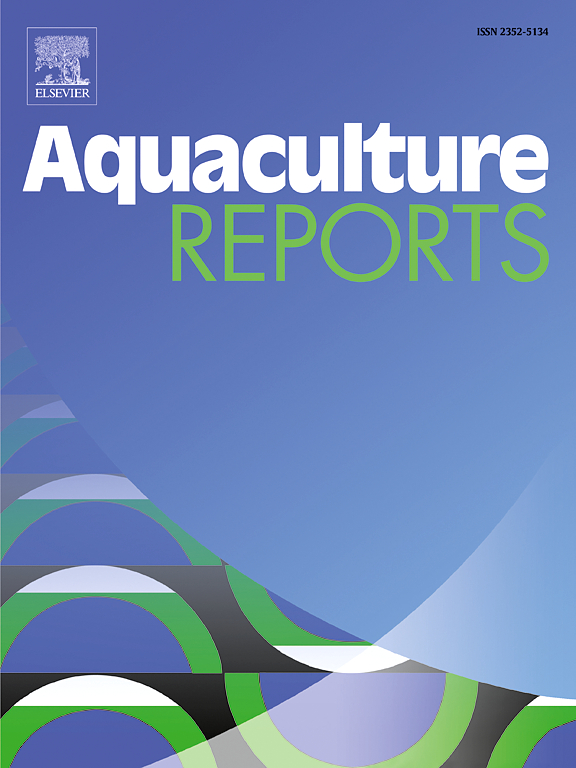基于体型和交配策略的橙泥蟹雌蟹繁殖性能研究
IF 3.2
2区 农林科学
Q1 FISHERIES
引用次数: 0
摘要
在自然或诱导育种中,亲鱼的大小是生产水产养殖种子的关键形态特征。因此,本研究确定了雌性母鱼大小对圈养橙泥蟹(Scylla olivacea)繁殖性能(产卵、卵子受精、孵化成功率、眼柄切除到产卵、产卵到孵化的间隔)的影响。本研究选用壳宽(CW) <; 100 mm和≥ 100 mm的雌性诱导交配(IM)和野生交配(WM)泥蟹获取幼虫。烧灼后,采用单侧眼柄消融(UEA)诱导交配雌性产卵。合并UEA后的潜伏期短(9-13 天),IM女性(CW≥100 mm)。与此同时,WM雌性(CW≥100 mm)的潜伏期变化较大(8 ~ 52 d)。只大螃蟹(CW≥100 毫米)记录成功孵化(IM: 90.88 ±0.98 %和WM: 92.16±0.70 %)和优越的产卵成功(IM: 86.67 ±11.55 %和WM: 73.33±23.09 %)。然而,卵细胞孵育期在IM和WM样品中相似(7-9 d)。由此可见,CW≥ 100 mm的IM和WM大雌鱼适合于圈养产卵。本文章由计算机程序翻译,如有差异,请以英文原文为准。
Reproductive performance of female orange mud crab, Scylla olivacea, based on body size and mating strategies
In natural or induced breeding, broodstock size is a critical morphological characteristic for producing aquaculture seeds. As such, the present study determined the effects of female broodstock size on the reproductive performance (spawning, egg fertilisation, hatching success, and interval from eyestalk ablation to spawning and spawning to hatching) of orange mud crabs, Scylla olivacea, in captivity. This study employed female induced-to-mate (IM) and wild-mated (WM) mud crabs with carapace width (CW) < 100 mm and CW ≥ 100 mm to obtain larvae. Post-cautery, unilateral eyestalk ablation (UEA) was conducted to induce spawning of the mated females. The latency period following UEA incorporation was short (9–13 days) in IM females (CW ≥ 100 mm). Meanwhile, the WM females (CW ≥ 100 mm) recorded varying latency period ranges (8–52 days). Only the larger crabs (CW ≥ 100 mm) documented successful hatching (IM: 90.88 ± 0.98 % and WM: 92.16 ± 0.70 %) and superior spawning success (IM: 86.67 ± 11.55 % and WM: 73.33 ± 23.09 %). Nevertheless, the egg incubation period was similar (7–9 days) in the IM and WM samples. Consequently, IM and WM large females of CW ≥ 100 mm are suitable for the larvae production of S. olivacea in captivity.
求助全文
通过发布文献求助,成功后即可免费获取论文全文。
去求助
来源期刊

Aquaculture Reports
Agricultural and Biological Sciences-Animal Science and Zoology
CiteScore
5.90
自引率
8.10%
发文量
469
审稿时长
77 days
期刊介绍:
Aquaculture Reports will publish original research papers and reviews documenting outstanding science with a regional context and focus, answering the need for high quality information on novel species, systems and regions in emerging areas of aquaculture research and development, such as integrated multi-trophic aquaculture, urban aquaculture, ornamental, unfed aquaculture, offshore aquaculture and others. Papers having industry research as priority and encompassing product development research or current industry practice are encouraged.
 求助内容:
求助内容: 应助结果提醒方式:
应助结果提醒方式:


